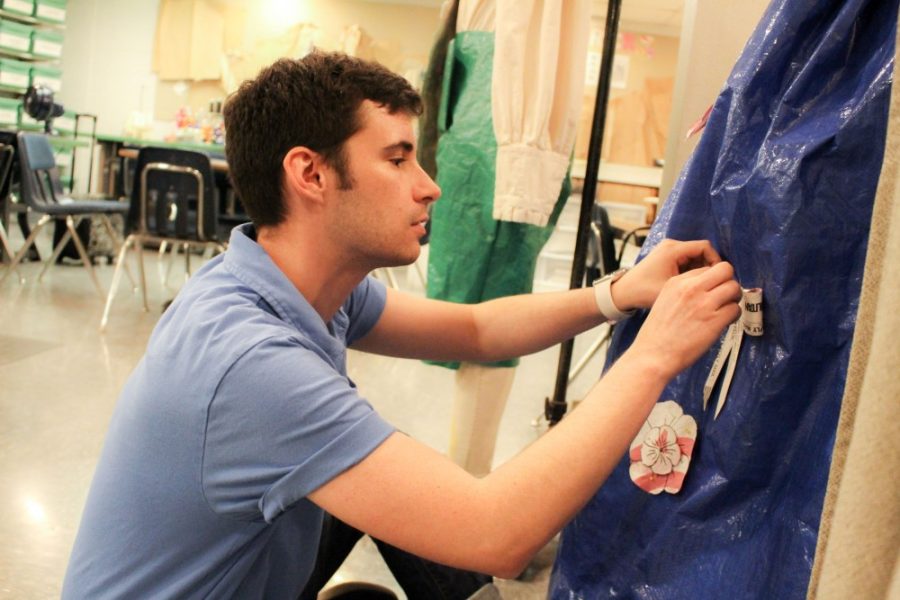Three University of Arizona graduate students will travel to the Czech Republic this summer to present their theater design project at an international festival.
Tori Mays, Rebekah Clark and Ryan Moore will represent UA at the Prague Quadrennial of Performance Design and Space, or PQ for short, in June.
The students said 11 other schools will also have students sharing their projects at PQ, which happens every four years to showcase theatrical design, architecture and scenography from around the globe.
“I think it’s going to be really cool to show our school and our program as a top contender,” said Moore, who is seeking a master’s degree in costume design.
Moore said the UA, the California Institute of the Arts and Carnegie Mellon University were the only three American universities that had students selected to present their work for PQ’s Common Design Project.
According to Mays, a third-year graduate student pursuing a master’s degree in lighting design, all students who participated in the project created a design plan for the same play script.
RELATED: UA alumna uses her degree to dance on the big screen
Mays worked on the lighting concepts, Moore did the costuming and Clark made a model of what the stage and audience space would look like for “Ubu Roi,” the 19th century play by Alfred Jarry that was assigned.
The trio said the play, which parodies Shakespearean plays such as “Hamlet” and “Macbeth,” centers around a political figure’s rise to power and deals with themes of tyranny, social class and corruption.
Moore said some inspirations for the costumes he designed were royal figures like Marie Antoinette and King Henry VIII, and the students used the theme of lavishness in “Ubu Roi” to get creative.
“One of the themes is excess,” Moore said. “But instead of focusing on money and riches, we wanted to do material excess.”
One costume Moore designed was a dress fit for a queen, but instead of being made of velvet or silk, it’s made of pink Sweet‘N Low packets. Another costume uses cardboard from 12 packs of Mountain Dew and plastic horse feed bags.
“It looks really fancy, but it’s made out of garbage, because that’s how ‘material excess’ came through for us,” Moore said.
Clark, a first-year graduate student pursuing a master’s in scenic design, said the idea of material excess in the form of trash helped her create what the stage and audience spaces would look like.
RELATED: UA dance clubs get ready to show their talents at local showcase
“The ideas translated into the scenic world by creating little mounds of trash for the audience to sit on,” Clark said. “It makes them a part of this story and brings the idea of class hierarchy to life by having the trash juxtaposed against the clean, minimalistic platform of the stage.”
Mays said the project had no budget, since the play won’t actually be performed, and this gave her the freedom of “unlimited technology” to design the show’s lighting.
“I basically used LEDs everywhere so we can have any color pouring out through the ceiling of the stage,” Mays said. “There are also fixtures on the outside that create shards of light to incorporate the audience in the setting. The light can make it look like there are jail bars or the colors can make the audience match the environment the characters are in.”
Mays said she also included fluorescent and ultraviolet lights to add more control and variety for how the stage and audience will appear.
Mays, Clark and Moore had UA professor Joe Klug help mentor them and provide feedback as they worked on the project.
Klug was involved with designing an exhibit for the United States Institute for Theatre Technology which he said was presented at the most recent PQ in 2015. He shared examples from that year’s festival with Mays, Moore and Clark of what other countries had done in the field of theater design to give them a broader sense of what theater looks like outside the U.S.
“That was kind of the goal of the project: to introduce our graduate students to this idea of ‘how do we engage in that larger worldwide conversation of where theater is going?’” Klug said. “For me, the goal with the PQ is just opening the students’ eyes to what theater can be.”
The trio, who have never been to Prague, said they are looking forward to being exposed to work by students and theater professionals from around the world at PQ.
“I’m excited to experience art that isn’t American,” Mays said. “In America we can get easily caught up in commercial theater and trying to make it this entertaining spectacle. I feel like other areas in the world make art not necessarily for money.”
Clark said she is excited that PQ is centered around the technical side of theater.
“I think the focus and discourse of theater tends to lean towards directors and writers and their vision,” she said. “So being in this environment where designers are all talking about how to push themselves forward is really exciting.”
Follow Jesse Tellez on Twitter









